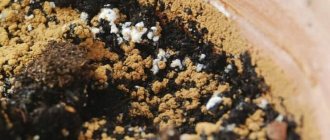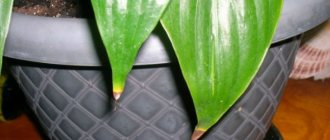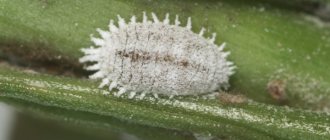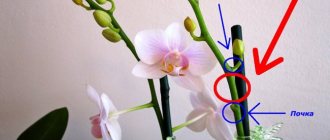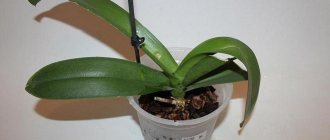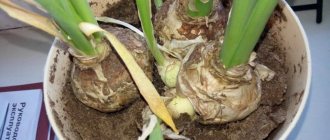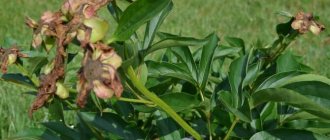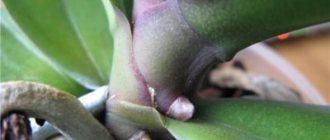Many people grow flowers in pots. This is both beautiful and useful. But sometimes owners encounter the following misfortune, like a white coating on the ground in pots. As experts say, the very fact of the appearance of plaque will not cause any particular harm to the plant, but the reasons that caused it can lead to the death of the flower. Let's figure out together the reasons for the appearance of plaque and how to deal with it. Let's also not forget about preventive measures, since it is better to prevent a disease than to treat it later.
After watering there is a white coating on the ground in the garden, what to do?
Mold and white coating in pots of indoor plants.
How to get rid of it? When caring for indoor plants, we often notice that mold or white plaque appears on the surface of the soil . Why mold appears in pots of indoor flowers and how to get rid of it is described in this article.
The appearance of mold on the ground is a threat to the health of an indoor flower in a pot, since mold can spread to the stem and cause rotting of the roots.
On the surface of the soil there is mainly white mold, similar to white fluff. This is a type of mold that grows in the top layer of soil. This fungus is widespread and often appears in flower pots under favorable conditions.
White coating or efflorescence are protruding crystals of soluble salts ; they appear on the surface of the earth, on the walls of the pot, on the base of the plant, and can be white, yellow or brown. The appearance of a white coating signals a deterioration in the quality of the soil in the pot, since the roots are in unfavorable conditions and can rot.
Why does mold or white residue appear in flower pots?
First of all, mold in a pot appears due to mistakes in caring for a houseplant:
– Mold is caused by overwatering . Many gardeners are afraid to dry out their indoor flowers and water them often and abundantly. In constantly damp soil, mold grows quickly. Water indoor flowers after checking the soil; its top layer should dry 2-3 cm before the next watering, then there will be no mold.
– Another mistake is watering a little, but often , so that only the top layer of soil in the pot gets wet. Consequently, the roots at depth do not get moisture, the plant looks dried out, and mold grows on the surface of the earth and efflorescence appears.
Properly watering a houseplant is necessary with small portions of water several times at intervals of 5 minutes until water appears from the drainage holes, which means the lump of earth is completely saturated with moisture and you can take a long break before the next watering.
– Mold and white coating appear due to stagnation of moisture in the soil , this happens if there are no drainage holes in the bottom of the pot, there is no drainage layer to drain excess water in the soil. Any leaked water into the tray must be drained after watering.
– A white coating appears on the surface of the earth when watering with hard tap water ; salts, along with watering, enter the soil, and then, when moisture evaporates from the surface, they are converted into crystals.
– Mold and white coating provoke the application of excessive doses of fertilizers , undeveloped mineral substances by the plant appear on the surface of the soil, and an excess amount of nutrients leads to the violent growth of mold.
– Mold and white coating appear if the plant is planted in a pot that is too large ; its roots cannot absorb the entire volume of soil and draw moisture and nutrients from it. Over time, unused soil becomes salty, sour and moldy.
– If you bought land and it is already moldy, then you cannot sow seeds or plant seedlings in it, or replant young plants , since mold can spread to fragile roots and stems, and as a result, the seedlings or seedlings will die.
How to get rid of mold and white deposits in flower pots?
1. When the soil in pots with indoor plants becomes covered with white fluff and smells rotten, you should change the watering schedule and water the flowers only after the top layer of soil has dried.
2. Loosen the surface of the soil in pots to break up the dense crust and allow air to pass into the deep layers of soil to the roots.
3. If there is a lot of mold, then you can get rid of it by removing the entire top layer of soil in the pot and filling it with new soil.
4. It is recommended to add bactericidal components to the soil for indoor flowers - pieces of charcoal and sphagrum moss have such properties.
5. The biological preparation “Fiosporin” will help against mold, which contains beneficial bacteria that prevent the development of fungi and rot. The drug in powder form must be diluted according to the instructions, left for a couple of hours and watered indoor flowers.
6. You can get rid of mold in pots using citric acid . Dilute half a teaspoon of citric acid in a glass of water and moisten the top layer of soil in the pot; an acidic environment is not suitable for the development of fungi and mold disappears. However, only those plants that like acidic soil can be watered with citric acid.
7. If mold and white coating cover the entire surface of the earth, then it is recommended to replant the plants with a complete replacement of the substrate . The soil for planting indoor plants must be disinfected by steaming in the oven.
Mold control methods
The constant moisture of the soil provokes mold infection, and the flowerpot becomes a real nursery. Proper watering and free drainage holes prevent stagnation. But what to do if the soil is already contaminated and there are bugs?
- Stop watering.
- Dry the root system.
- Replace the top layer of soil to a depth of 2-3 cm.
If these measures are not successful, then it will be necessary to completely replant the plant.
Transplanting a plant
To do this, the earthen ball along with the roots is pulled out of the pot and left to dry for 2 days. If a ceramic pot is used for planting, then it needs to be boiled for 20 minutes; if the pot is plastic or plastic, it is better to get rid of it, since there are fungal spores on its edges that will still remain fertile for several years.
After two days, you need to gently shake the roots and disinfect them. The old soil should be thrown away, and before planting, the new soil should be steamed in a water bath or in the microwave.
Expanded clay must be placed at the bottom of the pot, then soil is poured, a flower is planted and the top is sprinkled with coarse river sand. What will it give? First of all, regulating the flow of air to the roots, and therefore reducing humidity. This method of planting will also help if the overflow is small and accidental.
Soil disinfection
The soil disinfection method is considered one of the most effective. It not only helps eliminate odor and mold, but also completely destroys spores.
The procedure is carried out according to plan:
- Clear the roots from the soil as much as possible.
- Collect the soil and put it in a container.
- Pour boiling water over it.
- Pierce in the oven for 30 minutes.
- Cool completely.
- Treat the pot with a disinfectant.
- Pour the soil into the pots and plant the plant.
The soil can also be kept in a water bath. For this purpose, pour water into a pan, place a colander or sieve on top with gauze folded in several layers. When the water boils, add soil and cover with a lid. The soil is steamed in this way for at least 30 minutes. The plant is planted after the soil has completely cooled.
The soil must be fertilized or fed with minerals; you can add yeast.
Store-bought mold repellents
The purchased products are great for removing mold. Today they are sold in large quantities in specialized flower shops. The seller will select the necessary preparation for its intended purpose for treating the soil cover or the plant itself, and will tell you what to do with it.
Also consider the parameters for choosing a chemical:
- Features of the plant.
- For what type of soil?
- Availability of applied fertilizers over the last month.
- The amount of fungal infection spreading.
It is best to select a ready-made solution of organic origin. They already contain ingredients that block the further proliferation of fungal spores in the soil.
Why does the soil in the greenhouse turn white?
Many summer residents wonder why the soil in the greenhouse turns white, because they take such careful care of it, fertilize it, water it and weed it. So what is the cause of green soil, mold and white residue?
The most common causes are excessive soil moisture, pests and improper care.
The soil is sick for several reasons:
- If you water the soil endlessly.
- With increased soil acidity.
- When the greenhouse is poorly ventilated or absent at all, resulting in increased humidity in the room.
- If you add a lot of fertilizers to the soil.
These reasons can be combined with each other.
Pests, insects and diseases
Very often, pests lay their larvae in the soil, where they remain for a long time. If this problem is not dealt with, the number of harmful larvae in the soil will only increase. And some conditions can contribute to this, for example, heating the soil in the cold season, etc.
Ventilation diagram in a greenhouse.
The most common pests include:
- wireworms,
- cabbage flies,
- mole cricket,
- spider mite and others.
Other types of soil diseases include infections of vegetable crops - these are various mold spores and fungal diseases that can also penetrate the soil and cause its contamination. Many microorganisms are able to penetrate not only into the soil, but also constantly remain on the frame of the greenhouse itself (especially if it is made of wood). Therefore, if you carry out measures to disinfect the soil, it is necessary to touch all parts of the greenhouse in order to completely prevent the re-production of harmful microorganisms.
Common soil diseases:
- clubroot;
- late blight;
- spots on leaves;
- macrosporiosis;
- peronosporosis.
Soil waterlogging
Simple solutions for soil care.
If the soil is waterlogged, then in the near future you may find algae, fungus and mosses in your beds. This is also facilitated by warm air in the greenhouse. Particular insidiousness may come from groundwater, which may be located in the area of the greenhouse. Often, the owner of a greenhouse may not be aware of this and water his plants as usual, resulting in excessive moisture, which in turn leads to soreness and greening of the soil.
How to distinguish moss from algae? These two species can often be confused, but they have distinctive features:
- When the greenhouse lighting is poor, moss appears on the plants and soil.
- But if there is enough light in the greenhouse, then we can talk about the formation of algae.
How to distinguish
Mold and efflorescence can be difficult to distinguish by sight, but simply by touch. Efflorescence is dry and hard to the touch, it is difficult to confuse it with mold: the organic matter is soft, slightly moist, alive. In both cases, the color does not have to be white. For example, the red color of efflorescence indicates that iron and magnesium salts predominate in the water; It appears white when there are a lot of insoluble calcium salts (lime) in the water.
This is why there is little efflorescence if you use soft or settled water. By the way, there is a lot of efflorescence in snow water with excess sodium salts. If you are confident in the quality of the water, and efflorescence appears, the cause may be insufficient drainage, overly fertilized soil, or incomplete wetting of the soil.
Source 1olestnice.ru
It is especially easy to distinguish a fungal infection from efflorescence. Mold looks like a downy coating, thin threads are visible; Over time, it grows along the walls of the greenhouse. Both mold and efflorescence should not be ignored. You need to take the fact especially seriously when the soil in the greenhouse turns yellow or green; what to do in this case depends on the time of discovery and the age of the plants.
Causes of white plaque and measures to get rid of it
White coating is a yellowish crust consisting of salt. It can form for the following reasons:
- If the soil composition is considered mechanically heavy.
- Difficult soil drainage.
- With poor or scanty watering.
- Too much fertilizer in the soil.
- A large amount of fertilizing in the soil.
- The composition of irrigation water may contain large amounts of chlorine, calcium or magnesium.
- Dry air.
- Fungus or mold.
Ways to combat plaque.
The appearance of green and white deposits in the soil is associated with excessive waterlogging of the soil.
You can get rid of white deposits on the soil in different ways:
- For example, you can sprinkle the surface of the soil with expanded clay. It is on it that a white dried sediment will appear; from time to time the expanded clay needs to be washed and returned to its place again.
- Sprinkle the top layer of soil with river sand and loosen it more often. This is very beneficial for the root system of plants.
- You can remove the top layer of soil and add leaf humus.
- Remove the top layer of soil and fill in a new one.
- Purchase a soil deoxidizer from a specialty store. Remove the top layer of soil and pour the deoxidizer deeper.
- Water the soil with softened water. To do this, use a special filter. You can put a bag of peat in a bucket of water. If possible, water should be passed through a layer of peat, then the salts will be adsorbed.
Danger of white mold
If the soil of the seedlings becomes covered with white matter or mold, this leads to its death.
Therefore, as soon as the first signs of its appearance appear, measures must be taken to destroy it, because young shoots are not able to provide adequate resistance to fungal spores and die. If the seedlings fall out significantly, they will have to be replanted, which means a loss of time and extra money spent on purchasing seeds. And if the mistakes are not corrected, the mold will appear again and the plants may die. In this case, you will have to purchase young specimens from other gardeners. And this is not always a guarantee of acquiring the required variety.
Increased soil acidity
To reduce the acidity of the soil, which causes moss and mold to spread throughout the area (and this is detrimental to plants), you need to take the following actions:
- Add tree resin to the soil; this should be done from time to time. But not too often.
- Add lime to the soil.
- Dolomite flour added to the soil effectively eliminates soil diseases.
Norms for soil acidity levels.
It is advisable to add these fertilizers to the soil at the time of digging up the earth, before planting and after harvesting. In this case, the soil in the greenhouse will not deoxidize, causing mosses to stop appearing.
To ensure that plants grow well in the soil and produce a harvest, do the following:
- Sprinkle lime on the soil and do not dig up the soil.
- After this, sow green manure - this is a fast-growing grass.
- After the grass sprouts, plant seedlings of other vegetable crops in the soil.
- After the seedlings have taken root, the grass is mowed and subsequently used as mulching material.
How to Replace Topsoil
If you do not regularly ventilate the greenhouse, various diseases appear in the soil, from greening of the soil to the growth of parasite larvae. Stagnant warm air contributes to this. Therefore, it is very important to ventilate the greenhouse even in cold weather.
If the soil is already diseased, then the top layer of soil needs to be replaced. What do I need to do? And how to replace it correctly without harming the plants?
The process of removing the top layer of soil occurs as follows:
- The soil layer is removed to a depth of 30 cm.
- After this, the soil is covered with lime.
- The lime is slaked with water only the next day.
- Thus, the soil is left for 3 days.
- The lime is then covered with whitewash.
- Only then can you cover it all with a new layer of soil.
You can mulch the soil with the following materials:
Soil preparation is carried out before mulching. Mulch previously prepared and loosened soil.
Correct crop rotation in the greenhouse
In order for plants to grow well in a greenhouse, proper crop rotation must be observed. To do this, you need to know which plants like well-fertilized soil and which less fertilized ones.
Therefore, plants are divided into the following groups:
- Plants with low fertilizer consumption.
- With average fertilizer consumption.
- With high fertilizer consumption.
It is necessary to be able to alternate planting of such plants. For example, tomatoes consume a lot of fertilizers, and after harvesting, other plants with the least fertilizer consumption can be planted in this place.
Some tips for proper crop rotation.
Do not grow one variety of vegetables in the same place for years, alternate crops, this will avoid soil fatigue.
Select suitable neighbors from vegetable crops. For example, tomatoes and sweet peppers coexist in one garden bed. And basil planted nearby will also improve the taste of tomatoes, at least that’s what avid gardeners say. But it’s best to plant dill next to cucumbers.
There are plants that can repel parasites. For example, calendula and marigolds repel aphids and nematodes. And nasturtium whiteflies and aphids. To avoid soil diseases, use only high-quality planting material and fertilizers.
At the end of the season, do not neglect cleaning the planting material and cleaning the greenhouse. Remember that in a polycarbonate greenhouse, plants grow better and the soil suffers less.
Tips for getting rid of white deposits on the soil in pots
Many people grow flowers in pots. This is both beautiful and useful. But sometimes owners encounter the following misfortune, like a white coating on the ground in pots. As experts say, the very fact of the appearance of plaque will not cause any particular harm to the plant, but the reasons that caused it can lead to the death of the flower. Let's figure out together the reasons for the appearance of plaque and how to deal with it. Let's also not forget about preventive measures, since it is better to prevent a disease than to treat it later.
Why is mold dangerous for plants?
It is necessary to combat mold that appears on the ground immediately after detecting the first signs of damage. This fungus is very dangerous for plants and can lead to the following consequences:
- mold disrupts the process of plants absorbing nutrients;
- problems arise with the circulation of oxygen in the soil and, as a result, the roots of the plant suffer;
- fungus on the surface of the earth makes it difficult for moisture to evaporate and because of this, rotting of the root system begins;
- in advanced cases, the fungus can even lead to the complete death of the plant.
Mold on plants.
Reasons for the appearance of white plaque on the ground
Gardeners divide all the reasons into two groups:
- saline (mineral);
- fungal (bacteriological).
Let's look at each group separately.
So, the first group of reasons for the appearance of white deposits on the ground includes the following:
- improper watering;
- hard water;
- dry air;
- excess fertilizer in the soil;
- incorrectly selected substrate;
- The container is not suitable for this plant.
Improper watering
The most common cause of plaque. Regular waterlogging leads to the fact that moisture begins to actively evaporate. The result of this process is the deposition of salts on the surface of the substrate. In most cases, this happens if you use tap water for irrigation, due to its excessive hardness.
Everything would be fine, but excessive waterlogging leads not only to the appearance of a white coating on the soil of indoor plants, but also to rotting of the roots, and even black soil bugs will appear. All this leads to a halt in the development of the plant, and if treatment is not started in time, then to its death. Also, a white coating can appear for the opposite reason - due to lack of watering.
Wrong choice of soil mixture
Another mistake made by beginners, for whom the land sold in stores is the same. And novice gardeners, saving money, buy soil for planting, intended for growing seedlings. And they are very surprised to see a white coating after a while.
These are the remains of excess fertilizers and fertilizers that are not absorbed by the plant. You may ask, since you didn’t fertilize, where did the raid come from? It’s just that when producing the said soil, a lot of stimulants and fertilizers are added to it, designed to quickly hatch the seeds.
Lack of moisture
Dry soil is no less harmful than waterlogged soil, so do not forget to regulate the intensity and frequency of watering. Most often, this problem occurs when the indoor air is too dry, which happens in winter (due to heating devices) or in the summer months (during extreme heat).
Under such conditions, moisture evaporates too quickly, and salt deposits remain on the soil surface. The problem is that salt appears not only from above, but also inside the soil, which has a negative impact on the development of the flower.
To avoid this, use a special humidifier or simply place a bowl of water next to your flower pots.
Preventive measures
Using these tips, you can avoid the appearance of a white coating on the surface of the soil in flower pots:
Be more careful about watering. Do not start a new one while the top layer of soil is still wet from previous watering. Otherwise, you will simply oversaturate the soil with water and it will begin to stagnate. All this will lead to negative consequences for the flower;
Provide your plant with good drainage. To do this, the pot must have special holes at the bottom - this will help avoid stagnation of water in the container. Otherwise, it will lead to the appearance of fungus and mold. Also, before laying the soil, it is necessary to put a layer of expanded clay on the bottom of the container;
- Do not forget to periodically loosen the soil in the pot. This will make it more permeable to air, making it easier for the plant to breathe;
- For preventive purposes, it is recommended to water the soil with a solution of potassium permanganate once a month. This is to disinfect the soil from manifestations of the fungus;
- Don’t forget to regularly ventilate the room where the plants are located;
- The soil for planting must be of high quality; it is better to buy it ready-made in the store. But pay attention to the composition and its main purpose - the soil for seedlings is not suitable for adult plants;
- Use expanded clay as mulch. If it is not there, then you can replace it with river sand, or, in extreme cases, charcoal.
Now you have found out the reason for the appearance of white plaque in flower pots. Most of these reasons are associated with incorrect agricultural techniques, this is especially typical for beginning gardeners.
Therefore, if you provide your flower with proper care and the required conditions, you can easily avoid the appearance of plaque on the ground in your pots. And you can grow a wonderful, beautiful, and most importantly healthy flower.
Popular folk remedies
If the mold has appeared recently and the lesion is small, you can do without strong chemicals. So, to treat the soil, gardeners use a weak solution of citric acid: 2-3 grams per glass or just lemon juice (squeeze the lemon into a cup of water). The plant should be watered no more than twice a month. This product is suitable for flowers that can grow in acidic soil.
Sometimes ordinary garlic is used for disinfection. To do this, several cloves are buried near the plant or an infusion is made. When watered, garlic saturates the soil with phytoncides, which suppress the development of pathogenic bacteria.
Proper care will help get rid of mold.
Adding wood ash to the soil, treating with potassium permanganate, and spraying with a solution of dry mustard also has a positive effect.
